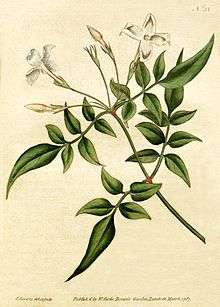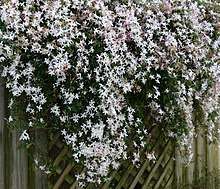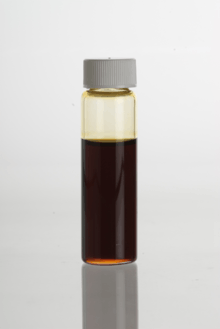Jasminum officinale
Jasminum officinale, known as the common jasmine or simply jasmine, is a species of flowering plant in the olive family Oleaceae. It is native to the Caucasus, northern Iran, Afghanistan, Pakistan, the Himalayas, Tajikistan, India, Nepal and western China (Guizhou, Sichuan, Xizang (Tibet), Yunnan). The species is also widely cultivated in many places, and is reportedly naturalized in Spain, France, Italy, Portugal, Romania, Croatia, Bosnia and Herzegovina, Montenegro, Serbia, Algeria, Florida and the West Indies.[1]
| Jasminum officinale | |
|---|---|
 | |
| Botanical illustration of Jasminum officinale | |
| Scientific classification | |
| Kingdom: | Plantae |
| Clade: | Tracheophytes |
| Clade: | Angiosperms |
| Clade: | Eudicots |
| Clade: | Asterids |
| Order: | Lamiales |
| Family: | Oleaceae |
| Genus: | Jasminum |
| Species: | J. officinale |
| Binomial name | |
| Jasminum officinale | |


It is also known as summer jasmine,[2] poet's jasmine,[3] white jasmine,[3] true jasmine or jessamine,[3] and is particularly valued by gardeners throughout the temperate world for the intense fragrance of its flowers in summer. It is also the National flower of Pakistan.
Description
Jasminum officinale is a vigorous, twining, bright, deciduous climber with sharply pointed pinnate leaves and clusters of starry, pure white flowers in summer, which are the source of its heady scent.[1]
Chemical Composition
It has alkaloids, coumarins, flavonoids, tannins, terpenoids, glycosides, emodine, leucoanthcyanins, steroids, anthocyanins, phlobatinins, essential oil and saponins.[4]
Garden history
Jasminum officinale is so ancient in cultivation that its country of origin, though somewhere in Central Asia, is not certain.[5] H.L. Li, The Garden Flowers of China,[6] notes that in the third century CE, jasmines identifiable as J. officinale and J. sambac were recorded among "foreign" plants in Chinese texts, and that in ninth-century Chinese texts J. officinale was said to come from Byzantium. Its Chinese name, Yeh-hsi-ming is a version of the Persian and Arabic name.[7]
Its entry into European gardens was most likely through the Arab-Norman culture of Sicily, but, as the garden historian John Harvey has said, "surprisingly little is known, historically or archaeologically, of the cultural life of pre-Norman Sicily".[8] In the mid-14th century the Florentine Boccaccio in his Decameron describes a walled garden in which "the sides of the alleys were all, as it were, walled in with roses white and red and jasmine; insomuch that there was no part of the garden but one might walk there not merely in the morning but at high noon in grateful shade."[9] Jasmine water also features in the story of Salabaetto in the Decameron.[10] Jasminum officinale, "of the household office" where perfumes were distilled, was so thoroughly naturalized that Linnaeus thought it was native to Switzerland.[11] As a garden plant in London it features in William Turner's Names of Herbes, 1548.
Double forms, here as among many flowers, were treasured in the 16th and 17th centuries.
Cultivars
Numerous cultivars have been developed for garden use, often with variegated foliage. The cultivar 'Argenteovariegatum'[12], with cream-white variegation on the leaves, has gained the Royal Horticultural Society's Award of Garden Merit.[13]
Aromatherapy and herbal medicine

The essential oil of Jasminum officinale is used in aromatherapy. Jasmine absolute is known as the 'King of Oils', and its heavy, sweet scent is loved by most people. The flowers release their perfume at dusk, so flowers are picked at night and a tiny amount of oil is obtained by solvent extraction. The result is a very expensive oil, but it can be used in low concentrations so it is not that uneconomic to use it in products. The aroma of jasmine is described as calming and soothing without being soporific.
As an herbal medicine, it is used in dermatology as either an antiseptic or anti-inflammatory agent.[14]
Jasminum officinale L. var. grandiflorum is a folk medicine used for the treatment of hepatitis in south of China. It has shown anti-viral activity in vitro.[15]
The effect of an aqueous extract of fresh floral buds of Jasminum officinale var. grandiflorum Linn. has been studied on female fertility in rats. The extract produced a significant decrease in serum progesterone levels.[16]
Safety
This oil can cause irritation in some people if used too frequently or in high concentrations. A major component of jasmine is benzyl acetate (~25%) which is known to be absorbed through the skin and known to be an allergic sensitizer. Those who show allergies to spicy food, perfumes and cosmetics are most likely to react. However, the power of the scent is such that only tiny amounts are required. Jasmine is also an emmenagogue and therefore should not be used during pregnancy.[17]
Etymology
'Jasminum' is a Latinized form of the Arabic word, 'yasemin' for sweetly scented plants.[18]
See also
- Jasminum sambac - also known as Arabian jasmine
References
- RHS A-Z encyclopedia of garden plants. United Kingdom: Dorling Kindersley. 2008. p. 1136. ISBN 1405332964.
- "BSBI List 2007". Botanical Society of Britain and Ireland. Archived from the original (xls) on 2015-01-25. Retrieved 2014-10-17.
- "Jasminum officinale". Germplasm Resources Information Network (GRIN). Agricultural Research Service (ARS), United States Department of Agriculture (USDA). Retrieved 2 December 2014.
- https://www.researchgate.net/publication/324521531_PHARMACOLOGY_AND_MEDICINAL_PROPERTIES_OF_JASMINUM_OFFICINALE-A_REVIEW
- Alice M. Coats, Garden Shrubs and Their Histories (1964) 1992, s.v. "Jasminum".
- Li, The Garden Flowers of China, 1959, noted in Coats (1964) 1992.
- Coats (1964) 1992.
- John Harvey, Mediaeval gardens (1981:48).
- Boccaccio, Decameron, third day.
- "They then took from the basket silver vases of great beauty, some of which were filled with rose water, some with orange water, some with jasmine water, and some with lemon water, which they sprinkled upon them".
- Noted in Coats (1964) 1992.
- "RHS Plant Selector - Jasminum officinale 'Argenteovariegatum'". Royal Horticultural Society. Retrieved 20 May 2013.
- "AGM Plants - Ornamental" (PDF). Royal Horticultural Society. July 2017. p. 56. Retrieved 14 March 2018.
- Rapini, Ronald P.; Bolognia, Jean L.; Jorizzo, Joseph L. (2007). Dermatology: 2-Volume Set. St. Louis: Mosby. p. 2049. ISBN 1-4160-2999-0.
- Zhao G., Yin Z., Dong J. ,"Antiviral efficacy against hepatitis B virus replication of oleuropein isolated from Jasminum officinale L. var. grandiflorum Journal of Ethnopharmacology 2009 125:2 (265-268)
- Iqbal M., Ghosh A.K.M., Saluja A.K. "Antifertility activity of the floral buds of Jasminum officinale Var. grandiflorum in rats" Phytotherapy Research 1993 7:1 (5-8)
- P. Joy and D.P. Raja. "Antibacterial activity studies of Jasminum grandiflorum and Jasminum sambac." Ethnobotanical Leaflets 12: 481-483. 2008. http://opensiuc.lib.siu.edu/cgi/viewcontent.cgi?article=1094&context=ebl
- Gledhill, David (2008). "The Names of Plants". Cambridge University Press. ISBN 9780521866453 (hardback), ISBN 9780521685535 (paperback). pp 220
| Wikimedia Commons has media related to Jasminum officinale. |